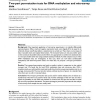Free Online Productivity Tools
i2Speak
i2Symbol
i2OCR
iTex2Img
iWeb2Print
iWeb2Shot
i2Type
iPdf2Split
iPdf2Merge
i2Bopomofo
i2Arabic
i2Style
i2Image
i2PDF
iLatex2Rtf
Sci2ools
BMCBI
2005
2005
Two-part permutation tests for DNA methylation and microarray data
Background: One important application of microarray experiments is to identify differentially expressed genes. Often, small and negative expression levels were clipped-off to be equal to an arbitrarily chosen cutoff value before a statistical test is carried out. Then, there are two types of data: truncated values and original observations. The truncated values are not just another point on the continuum of possible values and, therefore, it is appropriate to combine two statistical tests in a two-part model rather than using standard statistical methods. A similar situation occurs when DNA methylation data are investigated. In that case, there are null values (undetectable methylation) and observed positive values. For these data, we propose a two-part permutation test. Results: The proposed permutation test leads to smaller p-values in comparison to the original two-part test. We found this for both DNA methylation data and microarray data. With a simulation study we confirmed this ...
| Added | 15 Dec 2010 |
| Updated | 15 Dec 2010 |
| Type | Journal |
| Year | 2005 |
| Where | BMCBI |
| Authors | Markus Neuhäuser, Tanja Boes, Karl-Heinz Jöckel |
Comments (0)

